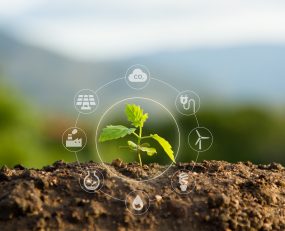
As world leaders gathered in Glasgow to map out a path to a more sustainable future, those of us in the logistics industry will have had a keen eye on events knowing the vital role sustainable supply chains will play in achieving the targets agreed at COP26.
However, how much progress is being made in the European road freight market? And how do future scenarios for carbon emissions look like playing out?
European Road Freight Market Co2 emissions (000s tonnes)
Source: Eurostat/Fraunhofer Institute/Ti
In the chart above, the red line shows the average annual reduction in emissions the European road freight market needs to track to reach carbon zero by 2050. The dark grey line presents current emissions level tracking market growth, while the light grey line shows the likely development of emissions given current technology, likely fuel technology developments, and expected market growth. These ‘best case’ factors include increasing efficiency gains as the asset mix in the market shifts towards newer Euro 6 trucks in the years to 2025. It then factors in further gains post-2025 as Euro 7 standards are introduced. It also shows European road freight remaining a long way off a 2050 Net Carbon Zero trajectory.
The data is also based on ‘Tank-to-Wheel’ (TtW) emissions, and therefore shows the emissions generated by trucks in motion and excludes the emission involved in producing and transporting fuel itself. That creates a very direct tie between market volume growth as measured in real terms and emissions, directly highlighting the importance of finding new carbon-neutral alternatives to power HGVs if the sector is to achieve Net Carbon Zero goals.
Using the Global Logistics Emission Council’s industry emissions data allows for the scale of European road freight’s emissions to be understood. The GLEC estimated that in 2015, global road freight operations accounted for 62% of all logistics industry emissions, or some 1.8bn tonnes. The analysis here shows that in 2015, European Road Freight’s TtW emissions accounted for around 11% of the global total, or 194.8m tonnes. The data shows that by 2019, European road freight TtW emissions have grown to around 215.8m tonnes, before dipping to 203m in 2020 as a result of lower volumes during the Covid-19 pandemic.
Creating a green road freight market will take action and development from the entire logistics sector, as well as from scientific communities around the world. Fuel technology is perhaps the most significant breakthrough needed, but as rates of empty running show more than one fifth (23%) of HGV transportation in Europe is effectively empty, the opportunity to optimise transportation operations also has a big role to play.
It’s perhaps already true to say that the drive to create a more sustainable logistics industry has gained more traction in 2021 than ever before. More LSPs now have emissions reduction targets and most big industry players have committed to being Net Carbon Zero by 2050. While this is progress, it marks only the beginning of the journey. A green economy requires a sustainable logistics industry and the data shows how much progress must still be made.
Source: Transport Intelligence, 04 November 2021
Author: Nick Bailey